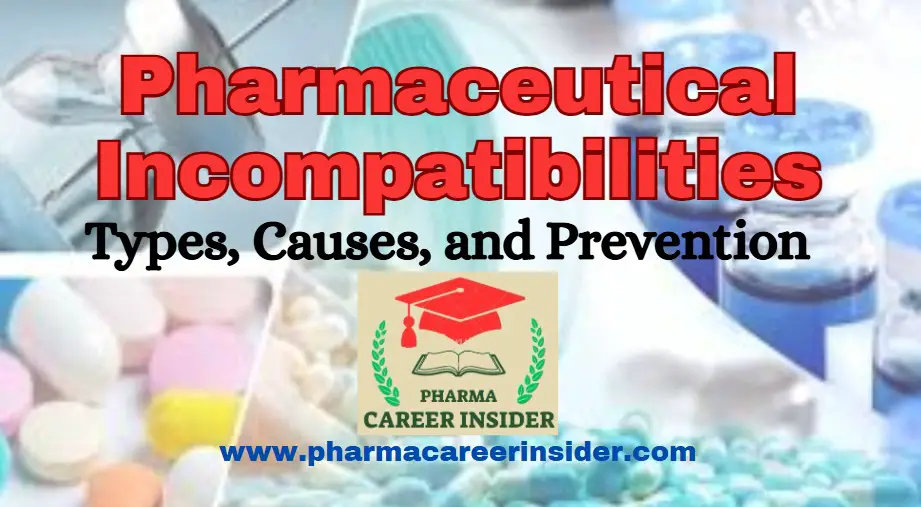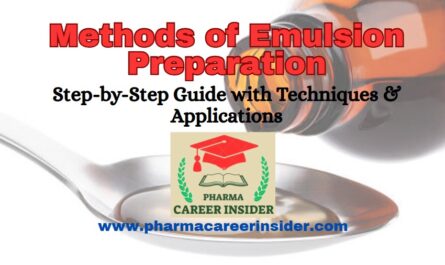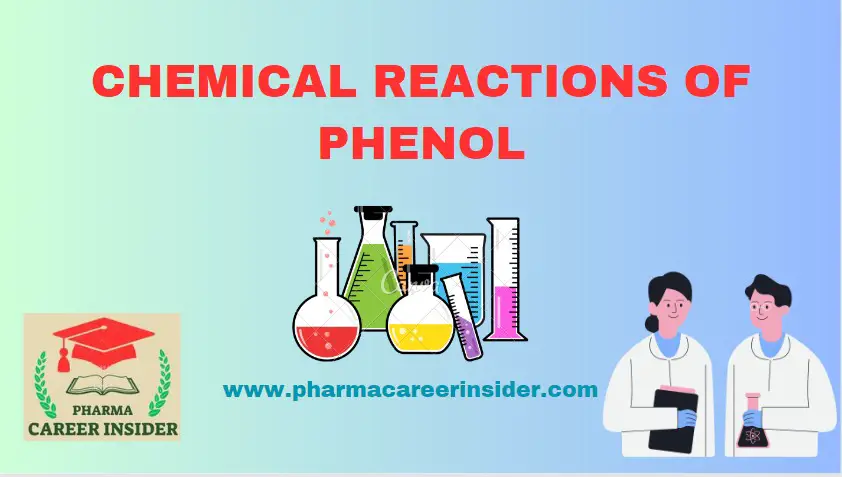Pharmaceutical incompatibility refers to the undesirable interactions between two or more components of a formulation, leading to instability, reduced efficacy, or potential harm to the patient. These incompatibilities occur during drug compounding, storage, or administration and can manifest in different ways, such as precipitation, discoloration, or reduced bioavailability.
Understanding the various types of pharmaceutical incompatibilities is essential for pharmacists, healthcare professionals, and formulators to ensure patient safety and drug stability.
Definition of Pharmaceutical Incompatibility
Pharmaceutical incompatibility is a physicochemical or therapeutic interaction between drug components that results in an undesirable change in the efficacy, appearance, or safety of the formulation.
Incompatibilities are classified into three main types:
- Physical Incompatibility (Change in physical state)
- Chemical Incompatibility (Alteration in chemical structure)
- Therapeutic Incompatibility (Undesirable pharmacological interactions)
Now, let’s discuss each type in detail with examples.
Classification of Pharmaceutical Incompatibilities
1. Physical Incompatibility
Physical incompatibility occurs when a drug’s physical properties are altered due to interactions with other components, leading to visible changes such as precipitation, phase separation, or color change.
Common Causes:
- Solubility issues: Some drugs are insoluble in certain solvents, leading to precipitation.
- pH variation: Changes in pH can cause certain drugs to precipitate.
- Interaction with excipients: Some excipients may cause aggregation or phase separation.
Examples:
- Calcium salts and sodium bicarbonate → Precipitation of calcium carbonate.
- Phenobarbital and water → Poor solubility leading to precipitation.
- Gum-based emulsions → Phase separation due to incompatible emulsifiers.
Prevention & Management:
- Use compatible solvents to improve solubility.
- Adjust pH levels using buffers.
- Modify the order of mixing to prevent separation.
2. Chemical Incompatibility
Chemical incompatibility occurs due to a chemical reaction between drug components, leading to degradation, toxicity, or loss of efficacy. This can result in oxidation, reduction, hydrolysis, or complex formation.
Common Causes:
- pH changes affecting chemical stability.
- Oxidation and reduction reactions between ingredients.
- Hydrolysis due to moisture exposure.
- Complexation causing reduced drug bioavailability.
Examples:
- Aspirin with water → Hydrolysis into acetic acid and salicylic acid.
- Vitamin C and ferrous salts → Oxidation leading to discoloration and loss of potency.
- Tetracycline with calcium → Complex formation reduces drug absorption.
Prevention & Management:
- Store drugs in airtight containers to prevent oxidation.
- Use stabilizers (e.g., antioxidants) to prevent degradation.
- Avoid mixing drugs with incompatible pH levels.
3. Therapeutic Incompatibility
Therapeutic incompatibility occurs when two or more drugs interact negatively within the body, leading to adverse effects, reduced efficacy, or toxicity.
Common Causes:
- Drug-drug interactions leading to reduced or enhanced effects.
- Pharmacodynamic or pharmacokinetic interference.
- Incorrect dosing leads to toxicity or ineffectiveness.
Examples:
- Aspirin and warfarin → Increased risk of bleeding due to enhanced anticoagulant effects.
- Tetracycline and milk → Reduced absorption due to calcium binding.
- Beta-blockers and insulin → Risk of severe hypoglycemia.
Prevention & Management:
- Review drug interactions before prescribing medications.
- Educate patients on food-drug interactions.
- Adjust dosages to avoid adverse effects.
How to Prevent Pharmaceutical Incompatibilities?
To minimize the risk of incompatibilities, pharmacists and healthcare professionals should:
- Conduct compatibility studies before formulating new drug combinations.
- Use stabilizing agents (e.g., pH buffers, antioxidants, chelating agents).
- Store drugs under controlled conditions to prevent degradation.
- Follow proper mixing sequences during formulation.
- Educate patients on drug-food interactions to prevent therapeutic incompatibilities.
Common Mistakes in Identifying Pharmaceutical Incompatibilities
Identifying pharmaceutical incompatibilities is crucial for ensuring the efficacy and safety of drug formulations. However, several common mistakes can occur during this process, leading to incorrect diagnoses or formulation errors:
1. Errors in Weight Measurement
- One of the most common mistakes is inaccurate measurement of drug or excipient quantities during formulation. Variations in weight can significantly impact the calculated displacement value or the final formulation stability.
- Solution: Use high-precision analytical balances and ensure that all measurements are performed under controlled conditions.
2. Overlooking Solubility Issues
- Not fully understanding the solubility properties of drugs in various solvents can lead to precipitation or poor drug absorption. Some drugs may appear to be incompatible because they do not dissolve properly in the selected solvent.
- Solution: Conduct solubility testing for each component before formulation and consider using solubilizing agents or altering the formulation method.
3. Misinterpretation of pH Effects
- pH plays a critical role in the stability and solubility of many drugs. Failing to account for the pH sensitivity of a drug can result in chemical instability or precipitation.
- Solution: Ensure proper pH buffering in formulations and regularly monitor pH changes during compounding to avoid unwanted reactions.
4. Inadequate Storage Conditions
- Failure to store compounded drugs under optimal conditions can lead to physical or chemical incompatibilities that would not otherwise occur.
- Solution: Follow proper storage guidelines, including temperature, humidity, and light exposure, to minimize the risk of incompatibility.
5. Lack of Compatibility Studies
- Incompatibilities might not be identified if a comprehensive compatibility study isn’t performed. This is especially true for new drug formulations where interactions with excipients may not be well known.
- Solution: Perform compatibility studies on every new formulation, including studies on different batch sizes and storage conditions.
Advanced Techniques for Drug Compatibility Testing
With the evolution of pharmaceutical technology, advanced methods for testing drug compatibility are becoming more sophisticated and precise. These methods help improve the reliability of drug formulations and reduce the chances of incompatibilities going unnoticed.
1. Digital Density Measurement Methods
- Digital densitometers provide precise measurements of the density of both drugs and excipients. This allows for more accurate calculation of displacement values, ensuring that drugs do not cause incompatibilities when incorporated into formulations.
- Benefits: High precision, quick results, and the ability to monitor multiple samples simultaneously.
2. AI-Driven Drug Compatibility Software
- Artificial Intelligence (AI) tools are increasingly being used to predict potential drug incompatibilities based on vast databases of chemical interactions. These tools analyze the molecular structure of drugs and excipients to foresee any possible incompatibility.
- Benefits: Faster identification of potential incompatibilities, reduced manual labor, and improved drug safety during the formulation stage.
3. High-Performance Liquid Chromatography (HPLC) for Stability Testing
- HPLC is widely used to analyze drug stability and detect changes in drug composition due to incompatibilities. It helps assess how drug formulations break down over time when exposed to different temperatures, pH levels, and other environmental factors.
- Benefits: Highly sensitive, reliable, and allows for the precise quantification of degradation products.
4. Spectroscopic Techniques
- Techniques like UV-visible spectroscopy, Infrared Spectroscopy (IR), and Nuclear Magnetic Resonance (NMR) provide valuable insights into the chemical structure and interaction of drug molecules with excipients.
- Benefits: Non-destructive, allows for real-time analysis, and provides clear molecular insight into incompatibilities.
5. In Vitro and In Vivo Drug Interaction Studies
- Conducting both in vitro (test tube) and in vivo (live animal) studies is crucial in assessing the real-world behavior of drug interactions. In vitro studies allow for controlled conditions, while in vivo studies provide a more accurate depiction of how drugs interact inside the body.
- Benefits: Provides a deeper understanding of drug performance, reduces the risk of adverse effects, and helps in determining the optimal formulation.
Regulatory Guidelines on Pharmaceutical Incompatibilities (USP, BP Standards)
Pharmaceutical regulatory bodies such as the United States Pharmacopeia (USP) and the British Pharmacopoeia (BP) establish comprehensive guidelines and standards for the identification, prevention, and management of pharmaceutical incompatibilities. Adhering to these guidelines is essential for ensuring product safety and quality.
1. USP Guidelines on Incompatibilities
- The USP offers detailed monographs for drugs, excipients, and formulations, outlining specific stability, compatibility, and storage requirements to prevent incompatibilities.
- Key Aspects:
- Monographs provide information on common interactions and potential incompatibilities.
- Stability testing protocols for various drug forms, including solutions, suspensions, and suppositories.
- Specifications for excipient compatibility with active pharmaceutical ingredients (APIs).
- Example: USP specifies conditions for the preparation and storage of intravenous solutions to avoid precipitation and degradation.
2. BP Standards for Drug Compatibility
- The BP provides a framework for evaluating the stability and compatibility of drug formulations in the UK. It includes guidelines for assessing incompatibilities across physical, chemical, and therapeutic domains.
- Key Aspects:
- Recommendations for handling and storage to prevent physical incompatibilities, such as precipitation or separation.
- Tests for identifying chemical degradation, such as oxidation or hydrolysis, particularly in injectable formulations.
- Guidelines for the safe use of drugs with known incompatibilities (e.g., combinations of high-risk drugs).
3. Regulatory Impact on Drug Formulation
- Pharmaceutical manufacturers must comply with the guidelines set forth by the USP, BP, and other regulatory bodies to ensure the safety, efficacy, and stability of their products.
- Best Practices:
- Perform required stability and compatibility testing for every new formulation.
- Ensure adherence to temperature, light, and humidity requirements during manufacturing and storage.
- Maintain accurate records of all testing and compliance procedures to pass regulatory inspections.
Conclusion
Pharmaceutical incompatibilities can lead to serious consequences, such as reduced drug efficacy, increased toxicity, and patient harm. Understanding physical, chemical, and therapeutic incompatibilities helps pharmacists and healthcare professionals prevent formulation issues and ensure patient safety. By following proper storage, formulation, and prescription practices, these incompatibilities can be minimized, ensuring the effectiveness and safety of pharmaceutical products.
Frequently Asked Questions (FAQs)
1. What is pharmaceutical incompatibility?
Answer: Pharmaceutical incompatibility refers to an undesired interaction between drug components, leading to instability, reduced efficacy, or potential harm.
2. What are the types of pharmaceutical incompatibilities?
Answer: The three main types are:
- Physical incompatibility (precipitation, phase separation, discoloration)
- Chemical incompatibility (degradation, oxidation, hydrolysis)
- Therapeutic incompatibility (negative drug interactions within the body)
3. How can physical incompatibilities be prevented?
Answer: Physical incompatibilities can be prevented by using appropriate solvents, adjusting pH levels, and following correct mixing procedures.
4. What is an example of chemical incompatibility?
Answer: Aspirin hydrolyzing in water to form acetic acid and salicylic acid is a common example of chemical incompatibility.
5. How can therapeutic incompatibility be avoided?
Answer: Therapeutic incompatibility can be prevented by reviewing drug interactions, adjusting dosages, and educating patients on food-drug interactions.




